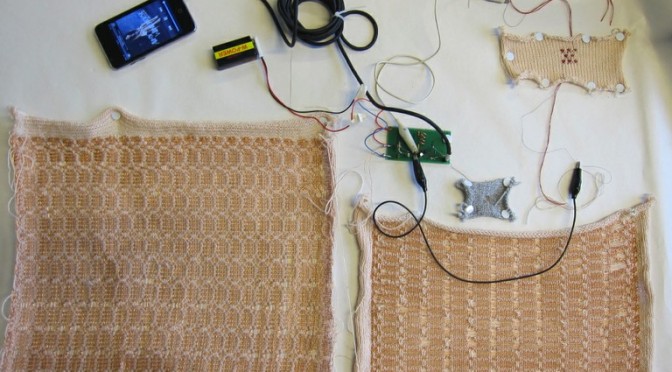Wow this post has spent a year in the drafts bin (since october 2018, and I first looked into this in 2017…), so I’m kicking it out as-is. I’ll update it later with moar pics ™:
In this week’s continued effort to clear out my back log of super-old blog post drafts, today we’ll talk about knitted radios.
You: Wait what, knitted radios?
Me: Yup, you heard me right. Knitted radios! First created in 2012, and then later in 2014 reincarnated as a sweater. Created by Ebru Kurbak and Irene Posch. To clarify, the knitted parts are the resistors, capacitors, and inductors (coils); the non-knit parts are the transistor, battery, and audio source. Since then, I believe they’ve also done work into making textile relays, switches, and logic gates.
Drapery FM 2012 ( Installation description from v2.nl )
Drapery FM (2012) is an audio-tactile installation by Ebru Kurbak and Irene Posch.
Drapery FM consists of a knitted piece of fabric that can electronically communicate the story of how it has been made to and through the surrounding radio receivers. The piece of fabric is essentially a micro FM transmitter that is, for the most part, made from copper wire and wool. Tuned into the right radio frequency, radios within the transmission range of this fabric receive and play out the sound recordings made during its production.
The installation proposes an atmospheric space made of airwaves. In tuning in with their personal radio receivers, moving in space or touching the fabric, participants can explore the spatial boundaries and haptic qualities of the installation. In the presence of a knitted electronic object viewers are invited to fantasize an alternative reality and speculate. What if, instead of purchasing hardware electronics we could directly knit them from scratch in our homes? In an imaginary world of home knitted electronics, how would we relate to our devices? Would we mend them with crossing threads for repair? Would we protect them with lavender sachets instead of silica gel? How would this alternation shift the way we value and prize materials, natural resources, geographical locations, personality traits, physical skills, and qualifications.
Technically, the underlying circuit is an adaption from Tetsuo Kogawa’s schematic of the “Simplest Radio FM Transmitter”. However, distinctively, electronic parts used as capacitors, resistors and the coil are made by knitting ordinary yarns together with electronically conductive yarns in deliberate configurations and patterns. Visually, the textile contains references to the ancient radio grill clothes that covered antique radios in the early 20th century.
Materials: Wool, Cotton, Copper, Silver, Stainless Steel, Silk, BC337 Transistor, 12V Power Supply, Audio Source, Radios.
Source: http://v2.nl/archive/works/drapery-fm
More about Drapery FM
A lot of pictures: http://v2.nl/files/2012/works/drapery-fm-documentation
General experiments
For more details, we turn to websites specific to the project.
Stitching Worlds is an artistic research project funded by the Austrian Science Fund (FWF): AR 284-G21 in the Programme for Arts-Based Research (PEEK).The project was carried out between May 2014 and June 2018 at the Department of Industrial Design 2, University of Applied Arts Vienna.
http://www.stitchingworlds.net/category/experimentation/
- Pearl embroidery display
- Dongguan Factory
- Pattern vs capacitance experiments
- Knitted vs hardware capacitor comparison
- Knitted capacitors
- Industrial Knitting machines
- Embroidered Relays and Logic Gates
- Crocheted relays
- Irene’s site
http://ebrukurbak.net/the-knitted-radio/ - Ebru’s site
http://ebrukurbak.net/draperyfm/

